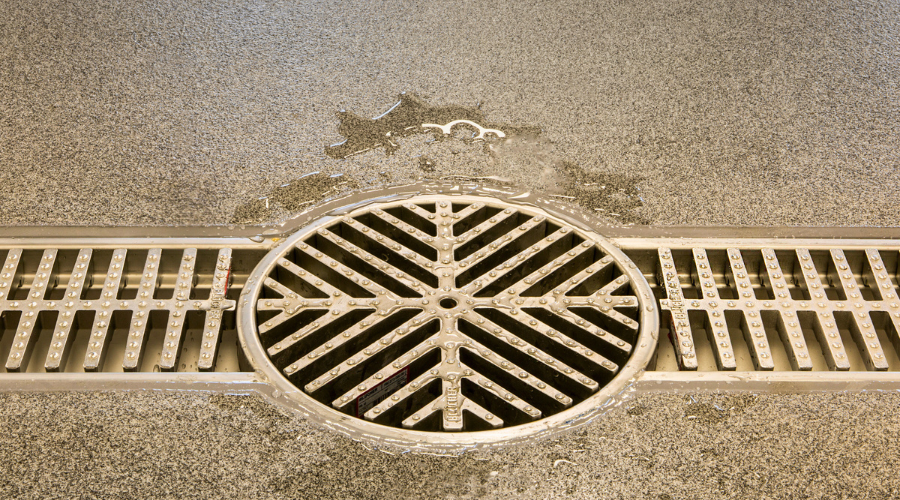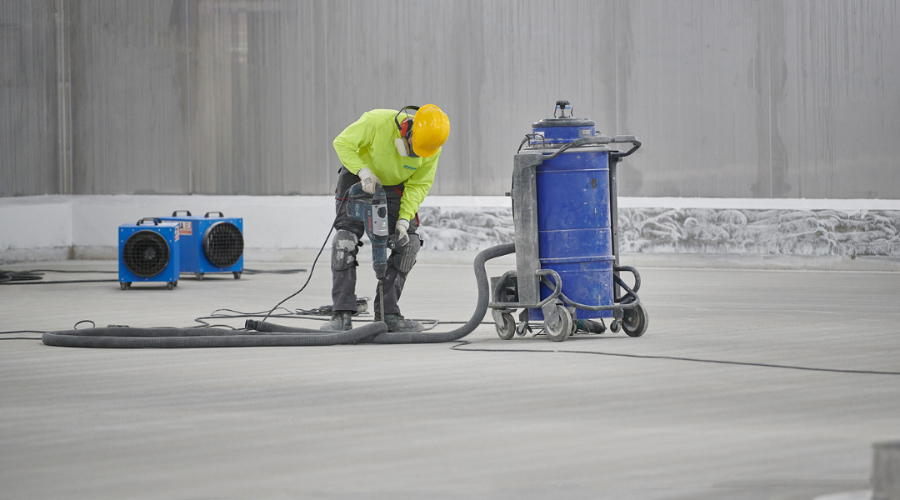Table of Contents:
Table of Contents:
Danger from Below – Moisture Vapor Transmission
There are several ways floors can be damaged by water, and not all damage is caused from above. For example, if your facility is in an area with a high-water table, moisture vapor transmission (MVT) may occur. MVT happens when the moisture from soil enters the concrete, or from water that exists within the concrete from the process of the concrete pour. Osmotic pressure or hydrostatic pressure causes this moisture to permeate upward through the concrete slab. When this happens, it can cause damage to your floors, such as blistering, bubbling, and delamination.

Moisture testing in concrete is crucial to ensure the long-term durability and performance of the structure. Proper moisture testing helps prevent these problems, ensuring a solid foundation for your resinous flooring system.
Concrete is Dry, Right?
Even where the water table is not high, the ground beneath a concrete slab is almost always damp with a relative humidity of 100%. This water vapor will make its way up through the slab and will dissipate into the air. There is always moisture in concrete, and it is always on the move. Even if a moisture barrier is under the slab, the concrete itself has moisture from the installation process. While some of this water reacts in the chemical process for the concrete to cure, there is water that is always added called “water of convenience” to ensure the concrete will flow. A brand new pour of concrete will have 100% relative humidity and due to a pressure gradient, this water will always work its way up and out into the air.
How to Test Concrete for Moisture Prior to a Flooring Installation
There are two types of tests for moisture:
1. Calcium Chloride Testing
This method tests the moisture coming out of the concrete. It is conducted by placing a petri dish with calcium chloride on the concrete slab with a plastic cover over a dish. The difference in weight from the start of the test to the end of the test will show how much moisture was absorbed into the calcium chloride. This method is becoming outdated. The humidity of any particular day can affect results and the calcium chloride test only measures moisture in the top half-inch of the slab. False positive and false negative results can occur.
2. Relative Humidity (RH) Testing
A more accurate test for moisture is relative humidity testing. This method involves probing down into the concrete with a drill and taking readings over time with a digital reader. This obtains accurate data on what is happening in the concrete. Unlike the calcium chloride test, ambient conditions do not affect the results of the relative humidity test.

Relative Humidity (RH) testing can help determine moisture levels in concrete.
Is Moisture Testing Always Needed Before Installation of a Floor?
Whether tests need to be conducted depends on the age of the concrete and the flooring product that is being installed. Some products, like liquid-rich systems (those without a mortar base) will require a moisture mitigation system to be installed first depending on the results of moisture testing. With concrete slabs that are over 25 years old, there is a risk that a moisture barrier was not installed. In this case, testing should always be conducted, or the installer should automatically use a moisture-mitigating system.
What Happens if Moisture is Not Handled Properly Before Installing a Floor?
There are standard procedures your flooring installer should follow to determine what is required for moisture mitigation in your facility before beginning the project. Without following these procedures, if steps are needed and ignored, moisture may result in the need for your floor to be repaired or replaced, causing you to lose productivity and revenue.
Possible issues from moisture damage:
- Resinous floors and sheet goods may blister, delaminate, or crack.
- Mold can grow beneath sheet goods, textiles, and wood.
- Wood can swell and crack.
How Stonhard Products and Installation Handle Moisture
Stonhard flooring experts are well-trained in moisture mitigation and use standard procedures to determine the need for testing and the appropriate steps to take before installing your floor. If concrete is new, our urethane mortar systems, such as Stonclad UT and Stonclad UR, can be installed on concrete within 5-7 days. Stonhard epoxy mortar systems, such as Stonclad GS, can be installed within 28 days on new 4–6-inch concrete. Stonhard liquid-rich (non-mortar) systems, such as Stonres RTZ, require a moisture mitigation system when readings are above 80% relative humidity.
Depending on the age of the slab and conditions on-site, Stonhard utilizes two different moisture mitigation systems:
1. Stonfil OP2, an osmotic-pressure-resistant grout used in conjunction with all Stonhard flooring systems. Stonfil OP2 is specifically designed to eliminate osmotic blistering of the floor caused by excess moisture occurring in slabs on or below grade. It may be used as a protective base grout for coatings and overlayments with low vapor permeability and on horizontal concrete surfaces where a vapor barrier is not present or not performing adequately. Stonfil OP2 is used when there is an existing slab with a known or potential moisture issue due to readings.
2. Primer 150, a green concrete primer for use on new concrete pours. Primer 150 allows for installation of the flooring system prior to achieving the proper relative humidity. A new concrete pour will have high relative humidity for months, if not years, so this is often required due to project schedules.
From testing and manufacturing to the installation process and final walkthrough, Stonhard products and installations deliver the highest quality flooring systems, formulated specifically for your space, anywhere in your facility.
About Stonhard
Stonhard is the unprecedented world leader in manufacturing and installing high-performance polymer floor, wall and lining systems. Stonhard maintains 300 territory managers and 200 application teams worldwide who will work with you on design specification, project management, final walk-through and service after the sale. Stonhard’s single-source warranty covers both products and installation. Contact us to learn more about our precision installation methods and specialized products.
Related Articles
Loving this Content?
Subscribe to upcoming topics!











